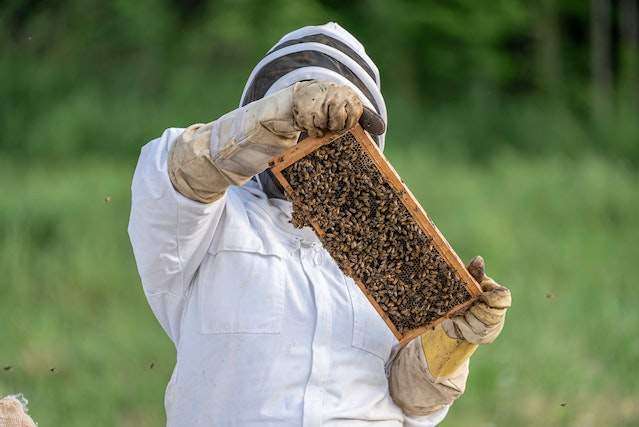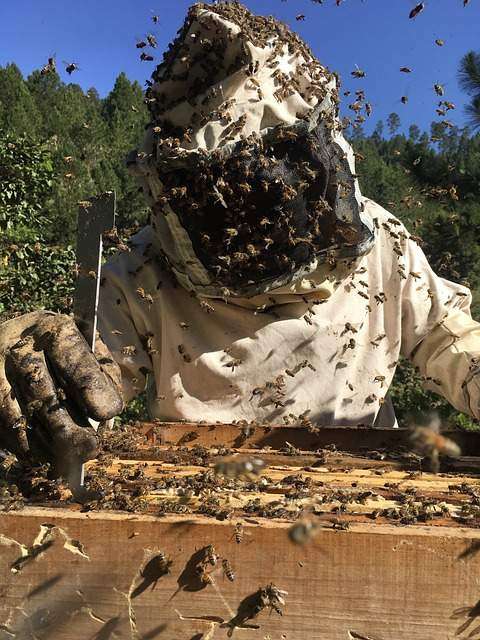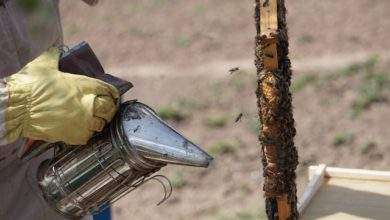What is the best type of bee gloves?

Beekeeping Gloves – Most of us know the pain of being stung by a bee. Even the most pliant bees will strike when a beekeeper opens a hive for harvesting. New beekeepers might find this distressing and often ask “what is the best type of bee glove?’
Investing in proper beekeeping gear like gloves is an excellent way to protect yourself from a bee sting. Technological advancements have come up to improve the way things are done today.
Specific risks in some occupations like beekeeping have been significantly reduced thanks to these innovative improvements. Beekeeping gloves are a natural way to protect against bee stings alongside bee suits and smokers.
Choosing the best gloves to protect yourself while handling beehives is imperative. There are several options for bee gloves ranging from leather, goat skin nitrile, and other fabric. When purchasing, one must look for agility, longevity, and the ability to protect from bee stings.
Gloves protect from bee stings that could be fatal at times and ensure sticky honey and pollen do not meet the hands. More importantly, since bees are delicate insects, it’s easy to spread infection and disease while handling the hive, as such gloves reduce the risk of spread significantly.
The head, face, and hands are the most vulnerable parts of the body when handling a beehive, and having the proper field-approved protective gear ensures no risk of sting or disturbance for the bees.
Beekeeping gloves are primarily designed and sold to enable beekeepers worldwide, both commercial and small scale, to handle their work with no distress.
The most common feature is a gauntlet base extending to the elbows and forearms for maximum protection. They are designed intrinsically to integrate well with the bee suit. At the point of contact with the elbows, elastic bands hold them in place to ensure they fit large and small forearms. This is because gloves are just a part of the full armor used when handling bees. A complete costume comprises a veil, a beekeeping suit and gloves.
Getting stung by a bee has different effects on a person. For some people, the sting manifests by swelling on the stung spot. Most people complain of itching which is an allergic reaction. This allergy is more prominent in adults than in children. The allergic reaction may cause strenuous breathing, nausea, unconsciousness, and tongue swelling in severe cases of bee stings. These scenarios highlight the importance of protective gear such as gloves and the bodysuit.
Swelling on the hands reduces hand mobility for a day or more, which could make someone unable to perform daily chores. It is thus essential to keep our hands protected at all times, especially when handling bees, as they are known to strike when provoked.
Openings are a perfect way for bees to crawl up and sting, and as such, it’s important to have gloves and body suits that cover all parts of your body to avoid the inconvenience of getting stung and taking off all your clothes in a rush. It’s also advisable to check your gear before donning them.
Various beekeeping gloves
Several materials are used to make gloves ranging from canvas, cowhide leather, goatskin leather, and nitrile.
Canvas Gloves
Canvas is a popular material with new beekeepers because of its availability in the market. It does the job but is not agile enough to let beekeepers handle other equipment. It is also not the most ideal for handling small insects like delicate bees. Canvas is much more affordable relative to cowhide or goatskin, thus its availability in hardware stores all around.
Nitrile Gloves
Nitrile gloves are considered the closest thing to being bare handed. They are made of a synthesized rubber that is thin enough to allow beekeepers to carry out sensitive tasks like handling the queen.
These types of gloves are usually washable. Technically, the nitrile gloves do not protect from stings. They are thin, and the bees can definitely sting through them.
Some disadvantages include:
Thin material, easy to tear and get stung
Coverage, only covers you hand up to your wrist
Hot, your hands will sweat in hot weather
Disposable, you will only get two, maybe three uses per pair – Bad for the environment
Rubber Bee Gloves
Beekeeping gloves made of rubber are a cheaper alternative to leather gloves. The heavy duty latex is usually easy to wash and many beekeepers use this type of glove when applying treatment to their hives.
However, rubber gloves offer very little dexterity and will make your hands sweat on hot summer days. Also, rubber gloves do not offer the same level of protection, as bees are sometimes able to sting through the latex.
Leather beekeeping gloves
There are three common types of leather used in beekeeping gloves:
- Pigskin
- Cowhide
- Goatskin
– Pigskin Bee Gloves
The pigskin beekeeping gloves are not as popular as either the goatskin or cowhide. The reason for this is that pigskin offers less range of motion for the beekeeper.
– Goatskin Bee Gloves
Goatskin leather are more supple than cowhide, allowing you to easily work the hive and manipulate the equipment. This is because goatskin can be split and shaved to a lighter weight than cowhide.
While not offering as much protection as cowhide, goatskin will keep most stings away from the skin.
Goatskin gloves are preferred by more beekeepers than any other type of glove.
– Cowhide Bee Gloves
Cowhide gives better protection against stings in addition to higher tensile strength, abrasion resistance, and a better stretch. A bee stinger will get stuck in the glove and is not able to penetrate the cowhide. The biggest disadvantage is that cowhide makes it more difficult to work with the bees, due to less dexterity.
Ventilated vs Non-Ventilated Beekeeping Gloves
Several features make for the ideal glove in the beekeeping occupation. A well-ventilated glove offers better airflow, thus ensuring sweat control for sweaty palms on a hot day. Bee harvesting and rearing is usually done during warmer weather, and this ventilation feature makes it more comfortable.
Elastic Cuffs
How effective are they?
Having elastic cuffs on beekeeping gloves ensures bees cannot crawl up your arm and sting. I would never purchase beekeeping gloves without elastic cuffs.
Wrist Protectors
Wrist protectors on a glove are an added advantage, especially when wearing shorter gloves. They protect the forearms covering the elbow. However, they are not necessary when handling leather gloves as they always have long sleeves. Elastic cuffs ensure bees cannot crawl up the arms to sting and makes a good feature for the ideal glove.
There are several glove options, but I have outlined one that has had good reviews in the market for doing an excellent job handling bees.
Buzz Beekeeping supplies Beekeeping Gloves
They are designed for both seasoned and new beekeepers as well as hobbyists. As an added protective feature, they are made from pure goatskin leather featuring sting-proof cuffs. To maximize airflow, the canvas of the sleeves is ventilated, keeping beekeepers cool, especially during a humid or hot day.
The glove’s design offers maximum flexibility, allowing easier handling of beehives and honey harvesting tools. They have a good warranty deal, giving 100% cashback within sixty days of purchase. They are available in different sizes ranging from XS to XL. The soft fabric and ventilated sleeves are these gloves’ main feature that makes them popular, especially among beekeepers from hot areas.






